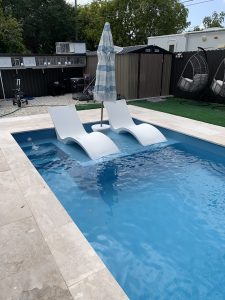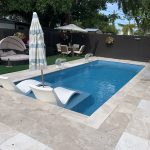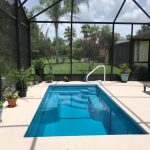Thinking about installing an inground swimming pool in your Florida backyard? You’re not alone. With year-round sunshine and warm temperatures, it’s no surprise many homeowners are turning their yards into personal paradises. Here’s a detailed, Florida-specific guide to what you can expect from start to finish. Before jumping in (pun intended) and if you live in a neighborhood with an HOA start with determining their requirements for an inground pool. Most HOA’s meet monthly and their design requirements vary for approval.
You should also have a copy of your boundary survey/plot plan to determine what your setback requiresments or if you have any easements on your property. Your local building department is there to help you and answer questions about your property and what’s possible.
Step 1: Design & Planning
Initial Consultation
The process begins with an on-site consultation where your pool builder assesses your property, listens to your vision, and discusses your budget, style preferences, and functional needs.
Choosing the Right Pool Type
In Florida, homeowners typically choose between fiberglass, concrete (gunite), or vinyl pools. Fiberglass pools are popular for their quick installation and low maintenance—ideal for the Florida climate.
Step 2: Permitting & HOA Approvals
County & Municipal Permits
Before construction begins, your builder will apply for necessary permits through your county or city building department. In Florida, this includes:
- Pool construction permit
- Electrical and plumbing permits
- Screen enclosure permit (if applicable)
HOA Approval (If Required)
If you live in a community with a homeowners association, your pool plans will likely need to be submitted for architectural review and approval.
Step 3: Site Preparation & Excavation
Utility Marking & Soil Checks
Before digging, utility lines must be located and marked. In sandy Florida soils, proper evaluation ensures no issues with stability or drainage.
Excavation
Once cleared, the excavation crew begins digging based on your pool’s layout. This typically takes 1–3 days, depending on soil and access.
Step 4: Pool Installation
Fiberglass Shell Delivery
If you’re installing a fiberglass pool, the pre-manufactured shell is delivered and carefully lowered into the excavated hole by crane.
Plumbing & Electrical
Contractors install plumbing lines, pool equipment (like pumps and filters), and electrical connections in compliance with Florida building codes.
Backfilling & Leveling
For fiberglass pools, the shell is leveled and backfilled with clean material to prevent settling and maintain stability.
Step 5: Decking, Coping & Features
Concrete Deck or Pavers
Choose from concrete, pavers, or travertine to finish your pool deck. Paver decks are extremely popular in Florida due to their heat resistance and visual appeal.
Additional Features
Now’s the time to add custom options like:
- LED lighting
- Waterfalls or fountains
- Screen enclosures (great for keeping Florida bugs out!)
Step 6: Inspection & Final Approval
Before the pool can be filled, local inspectors ensure everything complies with Florida’s safety and code requirements. This includes:
- Barrier inspection (pool fence or alarm system)
- Electrical inspection
- Final construction sign-off
Step 7: Pool Startup & Orientation
Filling & Water Chemistry
Once approved, the pool is filled and the water is balanced. Your contractor will typically include a startup service to ensure safe and clean swimming conditions.
Homeowner Training
You’ll receive a walkthrough of how to operate your equipment, maintain your pool, and use any automation or smart features.
How Long Does It Take to Build a Pool in Florida?
The timeline can range from 6 to 12 weeks depending on the type of pool, permitting delays, and weather. Fiberglass pools tend to have the fastest install times—sometimes as quick as 3–4 weeks after permits are approved.
Ready to Build Your Dream Pool?
At Rainforest Pools USA, we specialize in American-made fiberglass pools built for Florida’s unique climate and lifestyle. Let us guide you through every step—from design to splashdown.





